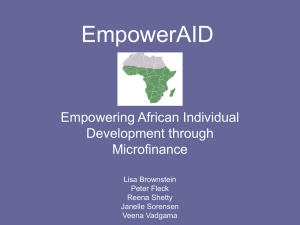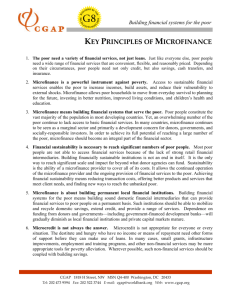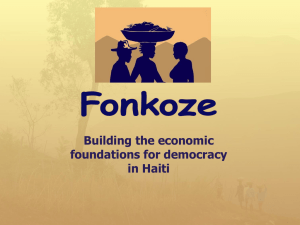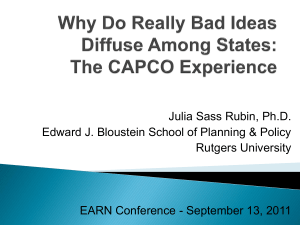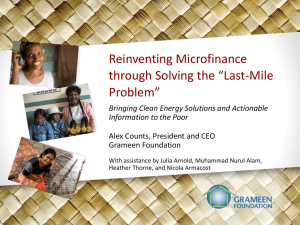Microcredit / Microfinance - The University of Winnipeg
advertisement
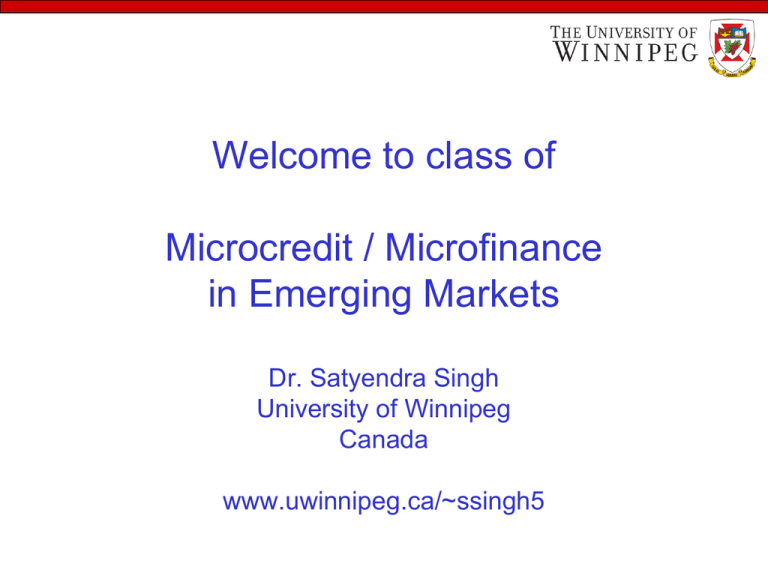
Welcome to class of Microcredit / Microfinance in Emerging Markets Dr. Satyendra Singh University of Winnipeg Canada www.uwinnipeg.ca/~ssingh5 How does it work? What is Microcredit Different from Conventional Banks • 5 features – Loan size is small b/w $100-$500 average $100 – Customers are rural poor, particularly women – Income activities Self-employment, non-formal sector – No collateral required – Must have saving account linked to MC Microcredit – Different from Informal $ Lenders • • • • MC No profit motives NGO’s approach to poverty alleviation Before the poor was blamed for personal failing Now, poverty deprive the poor of access to social resources human rights issue • Non-judgemental • MC leaders inspire social and economic revolutions in the EM by organizing the poor under the banner of MC organization (NGOs) Microcredit (MC) – Small loans • Why is MC important? – Four billion poor people need access to financial services – Social justice – Only philanthropy is not enough – Women suffering the most – Development of informal sector farmers, tailors… – Need to remove poverty in EM – ↑ Demand $50 billion per year for MC – ↑ 15-30% growth annually – Moral responsibility of businesses What is Microfinance: It is broad Loan, saving, insurance, money txfr… Debate: Microfinance • Sustainability • • • • • ↑ interest is ok to cover admn cost and be profitable Attract ↑ people to open MF venture ↑ competition ↑ innovation ↓ interest rate for clients Able to serve the 3 b people • Poverty alleviation • • • • ↑ interest is NOT ok because it exploits poor ↑ profit will attract ↑ MF investors Growth of new and uncertain sector Profit-making venture Microfinance (MF) Venture • Microfinance Profit-making venture – But serve the poor • Self-financed Savings/borrowing > lending – Share Capital collected from the public – Equity Capital supplied by owners of the MF venture • • • • • Owners have little equity capital Public has little interest in investing in the business Problem of seed capital not profitable at outset Assistance from private firms, donors agencies for seed capital Donors World bank, development banks, CIDA, USAID… Justification for Assistance to MF venture • 2 reasons for the justification – Social • Vast differences in wealth and education among people • MF Owners are not as greedy as banks (↑ interest rate from poor) • So, MF owners are different from traditional bankers – Economic • • • • Need help/grants/seed ↓ interest loan MF entrepreneurs able to deliver appropriate services & make $ Infant industries subsidize initial phase of operation ↑ productivity ↑ $ ↑ money mgmt skills resource mgmt ↓ transaction costs ↑ MF entrepreneur’s skills to be market oriented sound business decision contributes to economy Dr Yunus, President Clinton Social Consciousness-Driven Capitalism Theory • Psychological Component Dr. Md. Yunus – Capitalism premise we are selfish by nature ↑ $ – So, ok to develop capitalist enterprise (financial return) if fair to customers (social return/consciousness) • This premise creates 3 types of entrepreneurs – Traditional capitalist maximize financial return/profit – Philanthropic organisations traditional credit/NGOs – Microfinance enterprises combine both returns while making decisions subject to financial return cannot be negative social consciousness-driven capitalist enterprise SHG Self Help Group 10-15 women Social consciousness-driven Microfinance… • Reasons for investing in the MF – – – – – – – – – Large market size Unfulfilled demand ↑ return on investment despite ↑ admin cost ↓ default rate of borrowers 1-5% Success or failure is not linked to world political events Appealing due to altruism Helping poor directly and avoiding corrupt government Feeling good by doing good Investors may like the reasons to invest in MF venture IShop4Microfinance These firms donate X% to microfinance venture Social consciousness-driven Microfinance • But investors need to see sustainability of MF • Means of Entry Mainly motivated by ↑ rate of return • Equity stakes – For-profit orgn buys equity in MF difficult ↓ confidence • Securitization – Ability to securitize loans and sell access to cheaper capital for MF venture pass on the savings to clients • Service provision partnerships Insurance for loans • Donors self-sufficient $ should exit – Capacity building leverage other successful MF venture – Regulatory infrastructure credit bureau, rating, legal framework www.kiva.org How Kiva works?


